Marrying Vega and Zen: The AMD Ryzen 5 2400G Review
by Ian Cutress on February 12, 2018 9:00 AM ESTBenchmarking Performance: CPU Encoding Tests
One of the interesting elements on modern processors is encoding performance. This includes encryption/decryption, as well as video transcoding from one video format to another. In the encrypt/decrypt scenario, this remains pertinent to on-the-fly encryption of sensitive data - a process by which more modern devices are leaning to for software security. Video transcoding as a tool to adjust the quality, file size and resolution of a video file has boomed in recent years, such as providing the optimum video for devices before consumption, or for game streamers who are wanting to upload the output from their video camera in real-time. As we move into live 3D video, this task will only get more strenuous, and it turns out that the performance of certain algorithms is a function of the input/output of the content.
All of our benchmark results can also be found in our benchmark engine, Bench.
7-Zip 9.2: link
One of the freeware compression tools that offers good scaling performance between processors is 7-Zip. It runs under an open-source licence, is fast, and easy to use tool for power users. We run the benchmark mode via the command line for four loops and take the output score.
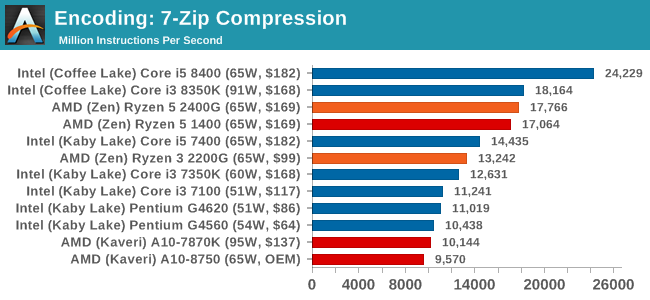
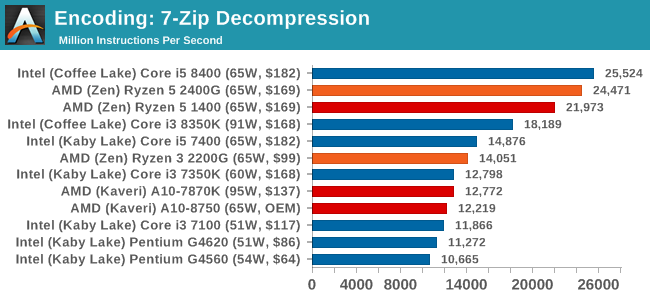
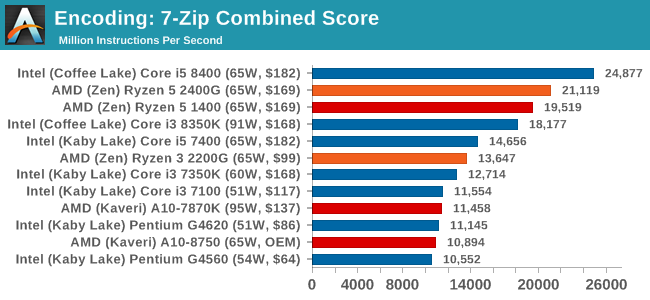
7-zip gives two contrasting stories here. For compression, full cores are needed to get the best performance, with frequency helping as well. However, for decompression, the extra threads help a lot. The combined result looks more like the decompression score, with the Ryzen 5 2400G sitting between the six-core Core i5-8400 and the quad-core Core i3-8350K.
WinRAR 5.40: link
For the 2017 test suite, we move to the latest version of WinRAR in our compression test. WinRAR in some quarters is more user friendly that 7-Zip, hence its inclusion. Rather than use a benchmark mode as we did with 7-Zip, here we take a set of files representative of a generic stack (33 video files in 1.37 GB, 2834 smaller website files in 370 folders in 150 MB) of compressible and incompressible formats. The results shown are the time taken to encode the file. Due to DRAM caching, we run the test 10 times and take the average of the last five runs when the benchmark is in a steady state.
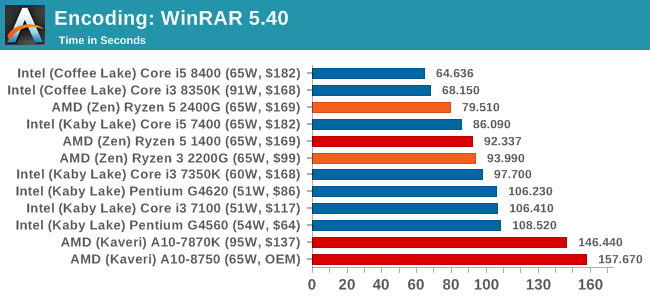
WinRAR is a good scaler with cores, frequency, and memory performance. The eight threads and DDR4-2933 contributes a good amount to the performance here, especially in light of where AMD was. The jump from the Ryzen 5 1400 to the 2400G is also noticable, due to the uptick in frequency and memory speed. The high single-thread performance of the Intel cores still wins out, however.
AES Encoding
Algorithms using AES coding have spread far and wide as a ubiquitous tool for encryption. Again, this is another CPU limited test, and modern CPUs have special AES pathways to accelerate their performance. We often see scaling in both frequency and cores with this benchmark. We use the latest version of TrueCrypt and run its benchmark mode over 1GB of in-DRAM data. Results shown are the GB/s average of encryption and decryption.
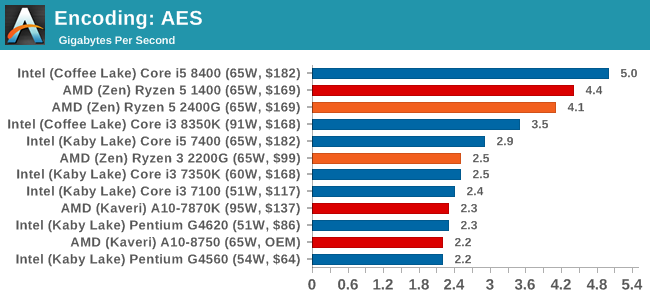
HandBrake v1.0.2 H264 and HEVC: link
As mentioned above, video transcoding (both encode and decode) is a hot topic in performance metrics as more and more content is being created. First consideration is the standard in which the video is encoded, which can be lossless or lossy, trade performance for file-size, trade quality for file-size, or all of the above can increase encoding rates to help accelerate decoding rates. Alongside Google's favorite codec, VP9, there are two others that are taking hold: H264, the older codec, is practically everywhere and is designed to be optimized for 1080p video, and HEVC (or H265) that is aimed to provide the same quality as H264 but at a lower file-size (or better quality for the same size). HEVC is important as 4K is streamed over the air, meaning less bits need to be transferred for the same quality content.
Handbrake is a favored tool for transcoding, and so our test regime takes care of three areas.
Low Quality/Resolution H264: Here we transcode a 640x266 H264 rip of a 2 hour film, and change the encoding from Main profile to High profile, using the very-fast preset.
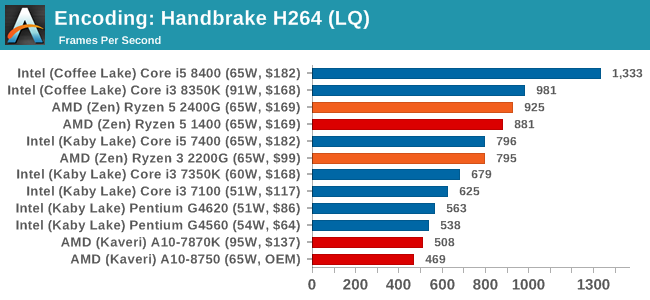
High Quality/Resolution H264: A similar test, but this time we take a ten-minute double 4K (3840x4320) file running at 60 Hz and transcode from Main to High, using the very-fast preset.
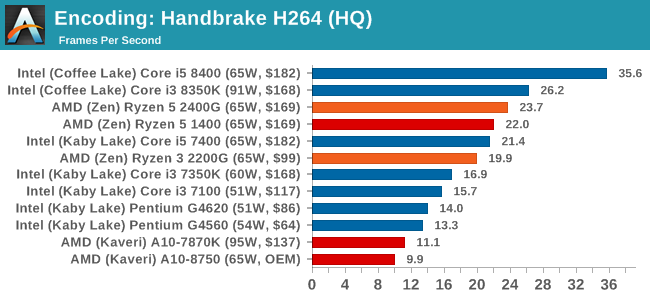
HEVC Test: Using the same video in HQ, we change the resolution and codec of the original video from 4K60 in H264 into 4K60 HEVC.
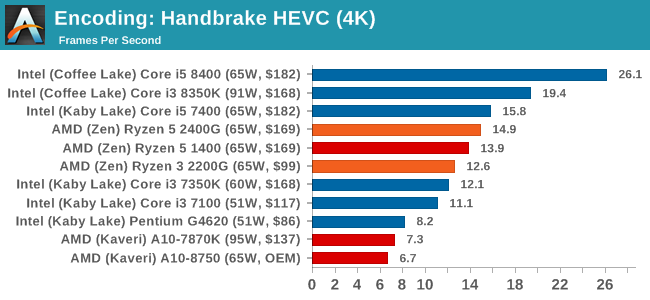










177 Comments
View All Comments
SaturnusDK - Saturday, February 17, 2018 - link
On the subject of allocated VRAM. It should be set as low as possible. The minimum is 64MB. You should never set it higher. Since VRAM is system RAM there is no speed gains to be had in GPU performance setting it higher than the minimum and just letting windows sort out the spill over but you are potentially limiting the CPU performance a lot as allocated VRAM eats available system RAM, so if you have 8GB but set VRAM to 2GB, the system only have 6GB remaining. This can seriously hurt performance in some cases. So, as little VRAM as possible is the correct setting.minidea - Tuesday, February 20, 2018 - link
<p><a href="http://www.minidea.co.in ">Minidea</a></p>Titoboyer24 - Saturday, February 24, 2018 - link
This Is Really A Great Stuff For Sharing. Keep It Up .Thanks For Sharing. <a href="http://www.mechanicalassignments.com/">Mec... Engineering Homework Help</a>Titoboyer24 - Saturday, February 24, 2018 - link
Get The Dissertation Writing Service Students Look For These Days With The Prime Focus Being Creating A Well Researched And Lively Content On Any Topic. Mechanical Engineering Homework Help http://www.mechanicalassignments.com/ ............Titoboyer24 - Saturday, February 24, 2018 - link
Only Professional Writers Can Make This Kind Of Material, Cheers<a href="http://www.spsshelponline.com/">SPSS Homework Help</a>
IntoGraphics - Friday, March 9, 2018 - link
For Ryzen 5 2400G + X370 mATX m/b.What 16GB (4x4GB) and 32GB (4x8GB) kits memory modules (brand + model) would easily overclock much higher than DDR4-2933 for the best GPU performance ?
(I'm looking at some 4000MHz kits but if that is not compatible it will be a waste.)
andrewbaggins - Tuesday, May 1, 2018 - link
Anandtech reviews continue to show us what the graphics chips CAN'T do well instead of what they CAN do well. I've heard all the reasons before, and they don't help. Gaming benchmarks should be presented for PLAYABLE settings rather than can-just-barely-run-it settings, i.e. High/Ultra. No gamer will settle for jerky, stuttery gameplay, so why not show us what the items under review can do on, say, Medium settings with a few High setting benchmarks thrown in for good measure?